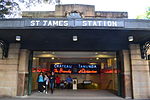St Mary's Cathedral College, Sydney

St Mary's Cathedral College (SMCC) is a systemic Catholic secondary day school for boys, located in the central business district of Sydney, New South Wales, Australia. Founded in 1824, it is the oldest Catholic school in Australia and among the oldest schools in the country, currently catering for approximately 770 students from Year 3 to Year 12. The college is administered by Sydney Catholic Schools of the Archdiocese of Sydney and operates as a systemic school; it is attached to St Mary's Cathedral. It serves as the choir school for the cathedral, and the choristers of St Mary's Cathedral Choir are drawn from the college. The school is currently the responsibility of the Congregation of Christian Brothers, administered via Edmund Rice Education Australia, and was the last school in Sydney to be served by Christian Brothers as both principal and deputy principal.
Excerpt from the Wikipedia article St Mary's Cathedral College, Sydney (License: CC BY-SA 3.0, Authors, Images).St Mary's Cathedral College, Sydney
Cathedral Street, Sydney Sydney
Geographical coordinates (GPS) Address Nearby Places Show on map
Geographical coordinates (GPS)
| Latitude | Longitude |
|---|---|
| N -33.871388888889 ° | E 151.21388888889 ° |
Address
St Mary's Cathedral House
Cathedral Street
2000 Sydney, Sydney
New South Wales, Australia
Open on Google Maps









